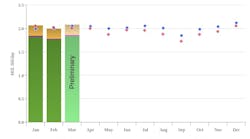By OGJ editors
HOUSTON, June 4 -- The Triassic Montney tight sand formation will provide the majority of the natural gas for the proposed Groundbirch gas pipeline in British Columbia and Alberta, TransCanada Corp.'s Nova Gas Transmission Ltd. told Canada's National Energy Board.
Of Groundbirch's projected throughput of 7.5 tcf, about 6.8 tcf would come from the Montney out of an estimated 40 tcf of marketable gas expected to be available from the formation, Nova said.
Conventional resources in the project drainage area would contribute the other 0.7 tcf. Nova noted that conventional gas production in the project drainage area comes from the Cadomin, Doig, Gething, Baldonnel, Halfway, Bluesky, and Charlie Lake formations above Montney and the Kiskatinaw below the Montney.
Construction on the 77-km, 36-in., 1.66 bcfd Groundbirch line is to start in the third quarter of 2010, and the expected service date is Nov. 1, 2010. The line is to run from Groundbirch, BC, to Gordondale, Alta., passing north of the Dawson Creek area.
Public estimates of original gas in place in the Triassic Montney tight sand formation in Northeast British Columbia range as high as 318 tcf, said Nova.
Nova said it used a 25% recovery factor compared with published estimates of 10% to more than 60% recovery from the Montney.
Nova projects flow on Groundbirch at 255 MMcfd in 2010-11 rising to more than 1 bcfd in 2015-16 and exceeding 1.4 bcfd by 2020-21 (OGJ Online, Feb. 27, 2009).
